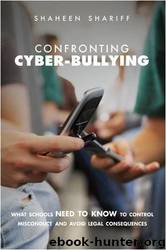Confronting Cyber-Bullying: What Schools Need to Know to Control Misconduct and Avoid Legal Consequences by Shaheen Shariff Ph.d

Author:Shaheen Shariff Ph.d.
Language: eng
Format: mobi, epub
Tags: &NEW, Internet and Children, Law, Social Science, Social aspects, Bullying in Schools, Computers, Administration, School Safety & Violence, Cyberbullying, General, Educational Policy & Reform, Automation, Internet and Teenagers, Computer crimes, Educational Law & Legislation, Internet, Bullying in Schools - Automation, Security, Education, Computers & Technology
ISBN: 9780521700795
Publisher: Cambridge University Press
Published: 2009-01-02T00:00:00+00:00
CENSORING CYBERSPACE: CAN KIDS BE CONTROLLED?
163
Question: In what form have those incidents of cyber-bullying typically occurred?
A. e-mail
B.
chat room or
bashboard content
C. content on
personal Web sites
B 44%
or blogs
A 45%
D. text messaging
C 32%
E. photographs or
DNK
video clips
26%
F. personal voting-
D 31%
F 15%
booth Web sites
E 19%
DNK (do not know/no
opinion)
figure 6.1. Typical forms of cyber-bullying. Reproduced with permission from the
Ontario College of Teachers (2007).
See Figure 6.1. The teachers considered criticism of their clothing, appear-
ance, and mannerisms, as well as of their grading practices, as the most serious
forms of antiauthority online expression. When asked whether they believed
such activities contribute to teachers leaving the profession prematurely, 19
percent of those surveyed believed it did. Twenty-one percent of the teachers
thought this also contributed to students dropping out of school, whereas 24
percent believed cyber-bullying affected student dropout rates. Twenty-four
percent felt it decreased classroom quality (because of the spill-over effect into
physical spaces).
Question: Which of the following best describes your school’s position on cyberbullying?
A. There are
formal, well
understood rules
with potential
DNK 10%
A 37%
consequences.
B. There may be
D 10%
formal rules but
they are not
widely
C 16%
B 27%
understood.
C. There are
informal rules.
D. There are no
rules.
DNK (do not know/no
opinion)
figure 6.2. School’s position on cyber-bullying. Reproduced with permission from the Ontario College of Teachers (2007).
Download
Confronting Cyber-Bullying: What Schools Need to Know to Control Misconduct and Avoid Legal Consequences by Shaheen Shariff Ph.d.epub
This site does not store any files on its server. We only index and link to content provided by other sites. Please contact the content providers to delete copyright contents if any and email us, we'll remove relevant links or contents immediately.
Sass and Compass in Action by Wynn Netherland Nathan Weizenbaum Chris Eppstein Brandon Mathis(7411)
Grails in Action by Glen Smith Peter Ledbrook(7305)
Secrets of the JavaScript Ninja by John Resig Bear Bibeault(5969)
Kotlin in Action by Dmitry Jemerov(4654)
Mastering Azure Security by Mustafa Toroman and Tom Janetscheck(3035)
Learning React: Functional Web Development with React and Redux by Banks Alex & Porcello Eve(2847)
WordPress Plugin Development Cookbook by Yannick Lefebvre(2628)
Mastering Bitcoin: Programming the Open Blockchain by Andreas M. Antonopoulos(2523)
The Art Of Deception by Kevin Mitnick(2305)
Drugs Unlimited by Mike Power(2196)
Kali Linux - An Ethical Hacker's Cookbook: End-to-end penetration testing solutions by Sharma Himanshu(2106)
Writing for the Web: Creating Compelling Web Content Using Words, Pictures and Sound (Eva Spring's Library) by Lynda Felder(2068)
SEO 2018: Learn search engine optimization with smart internet marketing strategies by Adam Clarke(2022)
JavaScript by Example by S Dani Akash(1951)
Wireless Hacking 101 by Karina Astudillo(1854)
DarkMarket by Misha Glenny(1850)
Full-Stack React Projects by Shama Hoque(1777)
Social Selling Mastery by Jamie Shanks(1752)
Hack and HHVM by Owen Yamauchi(1681)
